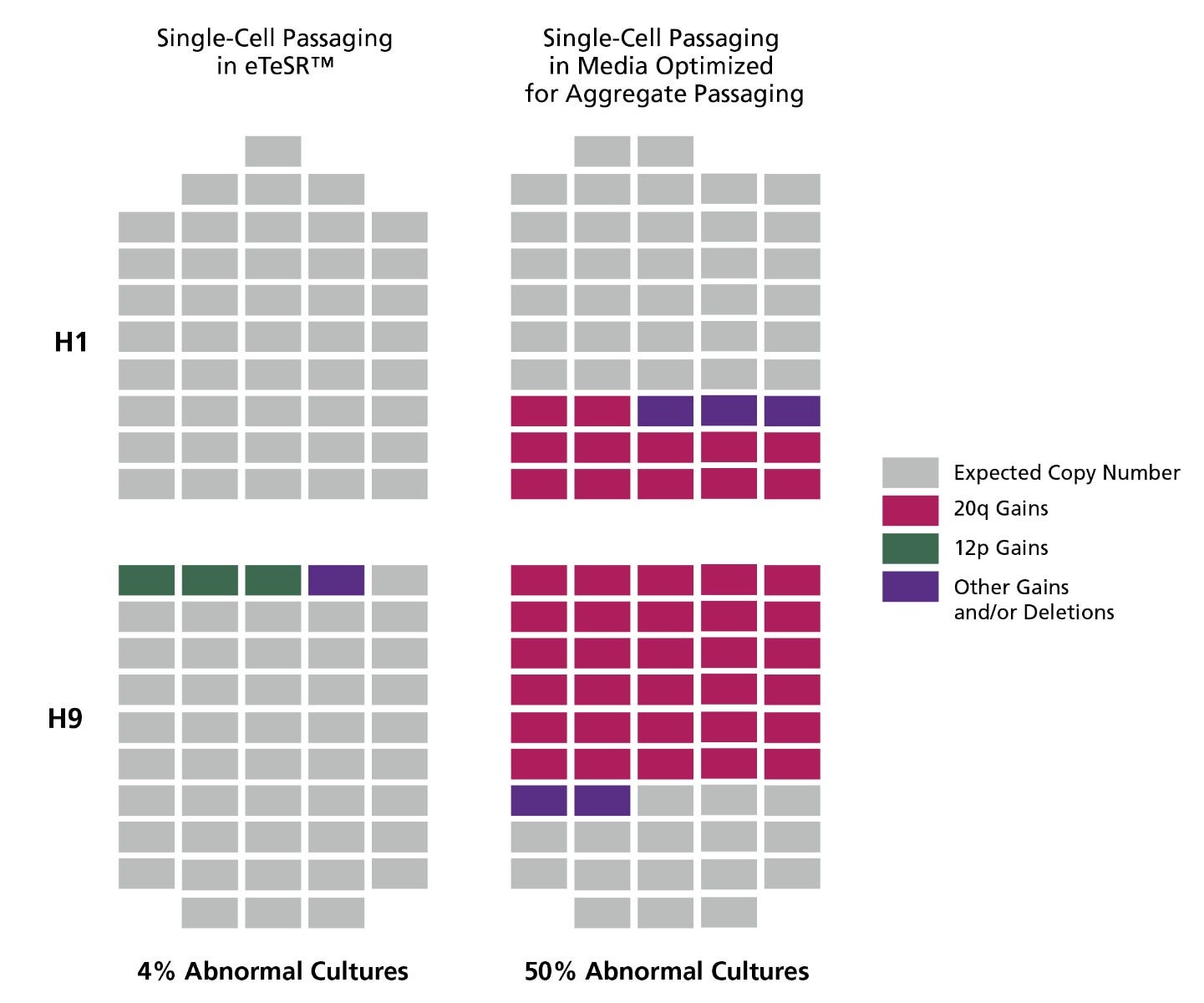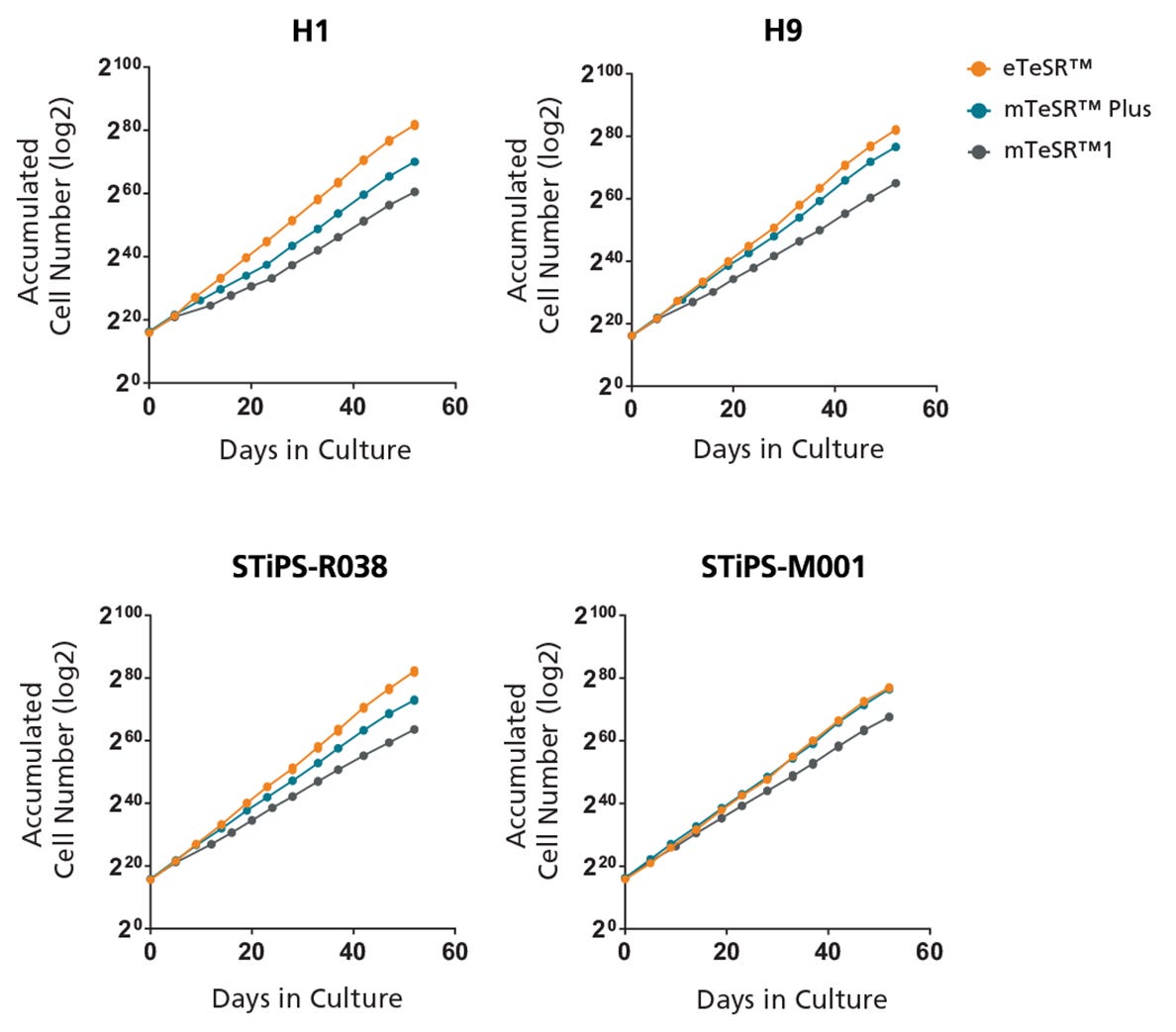eTeSR™
Enhanced hPSC Maintenance Medium Optimized for Single-Cell Passaging
If you’re performing human pluripotent stem cell (hPSC)-based research, the quality of your cells can have significant implications for the validity of your work. While traditional aggregate passaging is considered the gold standard method for maintaining hPSCs, some applications, such as automation and screening assays, can be simplified by routine single-cell hPSC culture.
eTeSR™, an enhanced feeder-free cell culture medium, is optimized to support the maintenance and expansion of hPSCs when cultured as single cells. Developed to improve the genetic stability of hPSC cultures by reducing the cellular stress associated with single-cell passaging, eTeSR™ can be used for routine maintenance or application-specific single-cell culture.
Explore below to view a scientific presentation from ISSCR 2023 that provides the rationale behind the development of eTeSR™ and an overview of some preliminary data. You can also find answers to frequently asked questions and a form where you can sign up to request a product sample.
Why Use eTeSR™?
- Increase cell yields while reducing the stress associated with single-cell passaging or high-density cultures
- Support cell quality while allowing for alternative feeding schedules with enhanced buffering, stabilization of key components (including FGF2), and optimized metabolites
- Complete your workflow with compatible gene editing, cloning, differentiation, and cryopreservation protocols
- Eliminate spontaneous differentiation
See the Data: Improved Genetic Stability and Cell Expansion
eTeSR™ has been specifically developed to support single-cell passaging, which typically involves shorter passaging schedules at high density. To cope with the increased metabolic demand and increased cell stress associated with this technique, eTeSR™ contains stabilized components, improved buffering capacity, and optimized metabolites to produce high-quality hPSCs with improved genetic stability.

Figure 1. eTeSR™ Improves the Genetic Stability of hPSC Cultures Maintained Long-Term Using Single Cell Passaging
Individual clonal sub-lines were derived from H1 and H9 hPSC lines using single-cell deposition. Clones (represented by each rectangle) were screened for recurrent abnormalities using the hPSC Genetic Analysis Kit prior to initiating long-term single-cell passaging experiments. Clones from each line were then cultured for 20 weeks (30 passages) using an automated platform in either eTeSR™ or media developed and optimized for aggregate passaging. After 20 weeks, clones were screened again using the hPSC Genetic Analysis Kit and any 20q and 12p abnormalities detected were confirmed using FISH. hPSCs cultured with routine single-cell passaging demonstrated significantly fewer clones (4% vs. 50%) that developed common recurrent abnormalities when maintained in eTeSR™, compared to media optimized for aggregate-based passaging.

Figure 2. hPSCs Cultured As Single Cells in eTeSR™ Exhibit Improved Cell Expansion
Four hPSC lines were single-cell passaged in either mTeSR™1, mTeSR™ Plus, or eTeSR™ on Corning® Matrigel®-coated plates using TrypLE™ Express for 11 passages. Cultures were maintained using a 4-5-5 day passaging schedule (see manual) using a restricted feeding schedule for mTeSR™ Plus and eTeSR™, and daily feeding for mTeSR™1. eTeSR™-maintained cultures show improved expansion rates compared to mTeSR™1 and mTeSR™ Plus when using single-cell passaging.
ISSCR 2023 Innovation Showcase
Enhancing Genetic Stability in Human Pluripotent Stem Cells Maintained As Single Cells: Introducing eTeSR™
View this webinar by Dr. Adam Hirst to hear about how hPSCs routinely maintained as single cells in eTeSR™ demonstrate higher genetic stability when tested against other commercially available media.
Try eTeSR™ in Your Lab
Sign up here or contact your local sales representative to request information about introductory offers to try eTeSR™.
Frequently Asked Questions
Why is STEMCELL Technologies now also recommending single-cell passaging of hPSCs?
At STEMCELL Technologies, our scientists have long recommended routinely passaging hPSCs as aggregates, as this method allows for the long-term expansion of many different cell lines while maintaining high cell quality and an expected karyotype.
However, single-cell passaging of hPSCs is becoming more widely adopted by researchers for routine maintenance as it allows for simpler workflows, less technical training, and compatibility with several applications. In spite of these advantages, long-term single-cell passaging has been linked to increased genetic instability in hPSC cultures, and few labs have rigorous quality control measures in place to assess the quality of these hPSCs.
To address this need, our scientists developed eTeSR™ (Catalog #100-1215), a novel hPSC maintenance medium optimized to support single-cell passaging of high-quality hPSCs.
Why was eTeSR™ developed?
eTeSR™, an enhanced hPSC maintenance medium, enables researchers to perform single-cell passaging of hPSCs while increasing cell yields and maintaining genetic stability. It has been developed to reduce the cellular stress associated with long-term single-cell passaging and can be used for routine hPSC maintenance or application-specific single-cell culture.
Existing TeSR™ media, including mTeSR™ Plus (Catalog #100-0276), were developed using aggregate passaging methods, which don't place the same amount of stress on cells as single-cell and high-density culture. Seeding of single hPSCs at low densities for cloning and gene editing can be performed with all our maintenance media when appropriately supplemented with CloneR™ (Catalog #05889) or CloneR™2 (Catalog #100-0691). However, we have observed improved survival and cloning efficiencies for hPSCs routinely maintained in eTeSR™.
Why use eTeSR™?
To cope with the increased metabolic demand and cellular stress associated with single-cell passaging, eTeSR™ contains key components that have been stabilized (including FGF2), improved buffering capacity, and optimized metabolites to produce high-quality hPSCs with improved genetic stability compared to hPSCs maintained in media primarily optimized for aggregate passaging. eTeSR™ is compatible with both daily and restricted feeding schedules while maintaining high cell quality and equivalent or increased performance.
How is eTeSR™ unique compared to the other TeSR™ media?
eTeSR™ is built upon previous TeSR™ formulations1-4—the most widely published feeder-free cell culture media for hPSCs—providing you with confidence on batch-to-batch consistency and experimental reproducibility. This novel formulation has been specifically developed to support single-cell passaging that typically involves shorter passaging schedules and higher culture densities.
References
- Chen G et al. (2011) Nat Methods 8(5): 424–9.
- Ludwig TE et al. (2006) Nat Methods 3(8): 637–46.
- Ludwig TE et al. (2006) Nat Biotechnol 24(2): 185–7
- Beers J et al. (2012) Nat Protoc 7(11): 2029–40.

